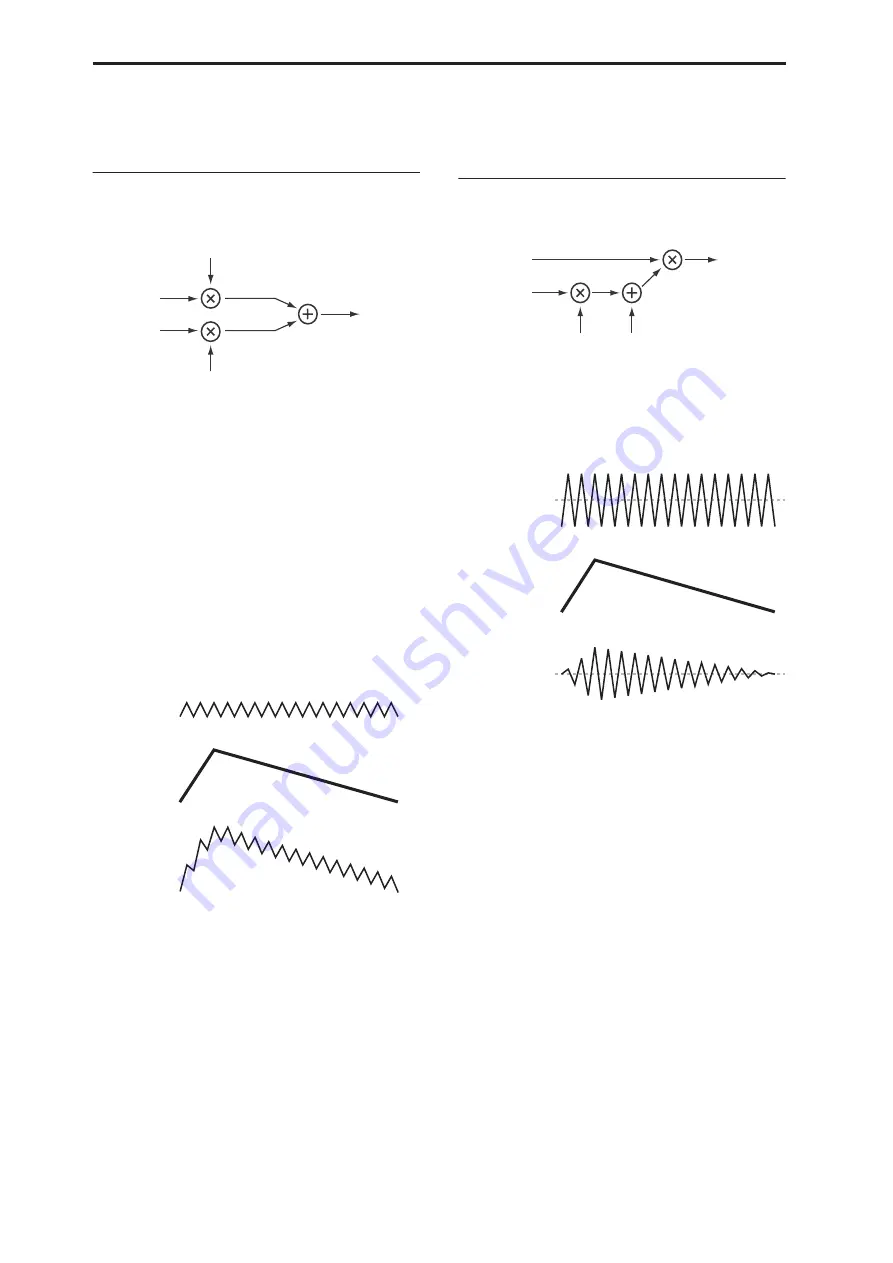
Program mode: HD-1
90
Gate
chooses between two AMS inputs (or fixed
values) based on a third AMS source. See “Gate” on
page 93 for more information.
A+B
AMS Mixer, Type = A+B
A+B merges two AMS sources into one. This can be
handy when you need to add one more modulation
source to a parameter, but you’ve already used up all
of the available AMS slots.
For instance, let’s say that you’re using an LFO to
modulate Filter Resonance, and then you decide that it
would be interesting to scale that parameter with an
EG as well. Resonance has only a single AMS input,
but you can easily merge the LFO and the EG together
using the A+B AMS Mixer:
1. Assign the LFO to AMS A.
2. Assign the EG to AMS B.
3. Assign the AMS Mixer as the Filter Resonance
AMS source.
AMS Mixer A+B example
AMS A
[List of AMS Sources]
This selects the first AMS input.
For a list of AMS sources, see “AMS (Alternate
Modulation Source) List” on page 967.
AMS A Amount
[–99…+99]
This controls the depth and direction of the AMS A
input.
AMS B
[List of AMS Sources]
This selects the second AMS input.
For a list of AMS sources, see “AMS (Alternate
Modulation Source) List” on page 967.
AMS B Amount
[–99…+99]
This controls the depth and direction of the AMS B
input.
Amt A x B
AMS Mixer, Type = A x B
This Mixer Type uses AMS B to scale the amount of
AMS A. For instance, you can control the amount
LFO1 with the Filter EG, or control the amount of the
Pitch EG with the ribbon.
AMS Mixer Amt AxB example
AMS A
[List of AMS Sources]
This selects the first AMS source, which can then be
scaled by AMS B. For a list of AMS sources, see “AMS
(Alternate Modulation Source) List” on page 967.
AMS A Amount
[–99…+99]
This controls the initial amount of AMS A, before
modulation from AMS B. Input from AMS B then adds
to this initial amount.
Even if Amount A is set to 0, AMS B can still control the
final amount of AMS A over the full +/–99 range.
AMS B
[List of AMS Sources]
This selects the second AMS source, to scale the
amount of AMS A. For a list of AMS sources, see “AMS
(Alternate Modulation Source) List” on page 967.
AMS B Amount
[–99…+99]
This controls the depth and direction of the AMS B
modulation of AMS A.
For example, if
AMS A
is set to
LFO 1
and
AMS B
is
set to the Filter EG,
positive
settings mean that the EG
will increase the amount of LFO1.
Tip: use SW 1/2 to turn an AMS source on and off
You can use Amt AxB to “gate” an AMS source:
1. Set AMS A to the desired source, and set AMS A
Output
AMS A
AMS B
Amt A
Amt B
AMS A: LFO
AMS B: EG
A+B Output
AMS A
AMS B
Amt B
Output
Amt A
AMS A: LFO
AMS B: EG
Amt A*B Output
Содержание Electronic Keyboard
Страница 1: ...Parameter Guide Parameter Guide ...
Страница 2: ......
Страница 180: ...Program mode EXi 170 ...
Страница 290: ...EXi STR 1 Plucked String 280 ...
Страница 572: ...Sequencer mode 562 ...
Страница 700: ...Global mode 690 ...
Страница 751: ...Insert Effects IFX1 IFX12 Routing 741 Fig 2 3a Fig 2 3b ...
Страница 902: ...Effect Guide 892 ...
















































